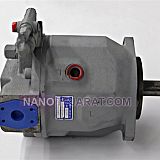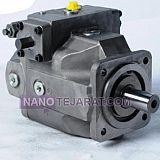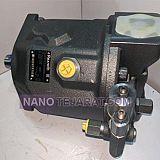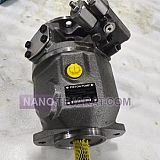| hydraulicmarket |
| Iran |
| 021-55130771 |
The Rexroth A10VSO hydraulic pump is an axial piston pump with variable displacement, commonly used in open-circuit hydraulic systems such as forklifts. These pumps are available in displacement ranges from 18 to 140 cm³/rev, providing flow rates between 59 and 252 liters per minute with a maximum operating pressure of 280 bar. Depending on the model, the pump speed ranges from 1,800 to 3,300 rpm. The swash plate design and compact construction ensure low noise operation and long service life, making it suitable for heavy-duty, high-frequency applications.
Repairing the A10VSO pump requires precision and technical expertise. The process typically begins with initial inspection, identifying issues such as pressure drop, unusual noise, vibration, or oil leakage. The pump is then disassembled following safety protocols, and internal components including pistons, swash plate, bearings, shaft, and O-rings are carefully inspected for wear or damage. Cleaning of all components and replacement of worn parts with original or equivalent-quality components is critical for restoring performance.
Finally, the pump is reassembled with precise adjustments, including setting the swash plate angle. A comprehensive performance test is conducted to verify flow rate, pressure output, and smoo

 | |
| hydraulicmarket | 021-55130771 |
| hydraulicmarket |
| Iran |
| 021-55130771 |
The Rexroth A4SO and A10VSO hydraulic pumps used in industrial press machines are axial piston pumps with variable displacement. They operate at pressures of 250 to 320 bar and flow rates from 20 to 350 liters per minute. The housing is made of hardened steel, and internal components are precision-machined to reduce wear and leakage. Seal rings and O-rings ensure stable performance at temperatures between 30°C and 90°C. The design allows for rapid replacement of internal components, minimizing downtime and ensuring consistent machine operation.
The main causes of failure include wear of pistons and cylinders, damaged O-rings, contamination of hydraulic oil, and operation under excessive pressure. Internal leakage reduces efficiency and output flow. Using hydraulic oil with incorrect viscosity or contaminated oil shortens pump lifespan. Malfunctioning control valves and pressure relief valves can also disrupt industrial press operation, necessitating specialized repair.
The repair process involves disassembling the pump, inspecting, and replacing pistons, cylinders, and O-rings. After component replacement, pressure and flow tests are conducted to ensure optimal performance. In severe cases, the housing may be rebuilt or shafts and bearings replaced. All replacement parts

 | |
| hydraulicmarket | 021-55130771 |
| parsianrahbalandeh |
| Iran |
| 02155130771 |
Repairing the Rexroth A10VSO hydraulic pump starts with complete disassembly of the housing, rotor, pistons, and control plate. Each component is measured with 0.05 mm precision to detect wear or deformation. Pistons, springs, and tappets are inspected for cracks, erosion, or fatigue. Worn seals, O-rings, and washers are replaced to ensure zero leakage. Cleaning uses hydraulic-grade solvent, followed by drying in dust-free conditions. Disassembly also involves documenting part numbers for accurate replacement and verifying all tolerances against Rexroth specifications.
During assembly, the rotor is aligned within the housing, and the rear plate is adjusted to maintain 40–50 MPa nominal operating pressure. Shaft torque and preload are carefully calibrated. Flow rate and volumetric efficiency are tested at 2200–2500 rpm on a calibrated test bench. Common operational issues include low pressure, internal leakage, or excessive noise. Addressing these faults requires precise replacement of worn pistons, springs, or the rear plate and realignment of internal components to prevent premature failure.

 | |
| parsianrahbalandeh | 02155130771 |
| parsianrahbalandeh |
| Iran |
| 02155130771 |
Repairing the Volvo L90 A10VSO hydraulic pump begins with fully disassembling the housing and removing the rotor, pistons, and rear plate. Rotor and main shaft surfaces are measured with 0.05 mm precision to detect wear or misalignment. Pistons and springs are inspected and replaced if cracked, worn, or broken. All seals and O-rings are replaced to prevent hydraulic leaks. Components are cleaned with specialized hydraulic solvent, dried, and prepared for reassembly.
Assembly starts with precise installation of the rotor in the housing and alignment of the rear plate. Shaft torque and preload are adjusted to achieve 40–50 MPa operating pressure. Flow rate and volumetric efficiency are measured on a test bench at 2200–2500 rpm. Common issues include excessive noise, reduced output pressure, and internal leakage, which are resolved by replacing worn parts and accurate shaft alignment.

 | |
| parsianrahbalandeh | 02155130771 |